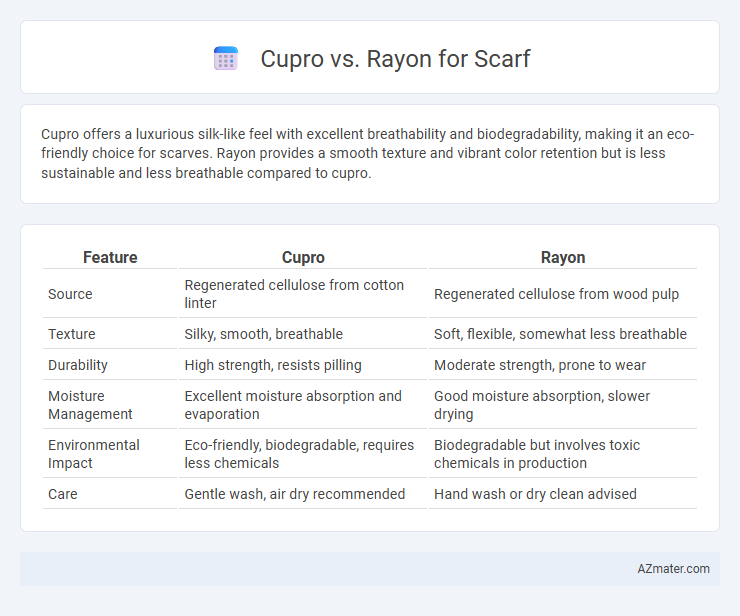Cupro offers a luxurious silk-like feel with excellent breathability and biodegradability, making it an eco-friendly choice for scarves. Rayon provides a smooth texture and vibrant color retention but is less sustainable and less breathable compared to cupro.
Table of Comparison
| Feature | Cupro | Rayon |
|---|---|---|
| Source | Regenerated cellulose from cotton linter | Regenerated cellulose from wood pulp |
| Texture | Silky, smooth, breathable | Soft, flexible, somewhat less breathable |
| Durability | High strength, resists pilling | Moderate strength, prone to wear |
| Moisture Management | Excellent moisture absorption and evaporation | Good moisture absorption, slower drying |
| Environmental Impact | Eco-friendly, biodegradable, requires less chemicals | Biodegradable but involves toxic chemicals in production |
| Care | Gentle wash, air dry recommended | Hand wash or dry clean advised |
Introduction to Cupro and Rayon
Cupro is a regenerated cellulose fiber derived from cotton linter, prized for its silk-like texture, breathability, and eco-friendly production process, making it an excellent choice for scarves that offer softness and comfort. Rayon, also a cellulose-based fabric made from wood pulp, provides a smooth, lightweight feel with good drape, commonly used in fashion scarves for its affordability and versatility. Both fibers exhibit moisture-wicking properties and a luxurious sheen, but Cupro's sustainable production and hypoallergenic qualities often distinguish it in high-end scarf applications.
What Is Cupro?
Cupro, a regenerated cellulose fiber derived from cotton linter, offers a silky texture and excellent breathability, making it ideal for scarves that feel lightweight and luxurious against the skin. Unlike rayon, which is also cellulose-based but often produced through more chemically intensive processes, cupro undergoes a refined production that results in a soft, smooth fabric with a natural sheen and high moisture absorption. Its eco-friendly properties and hypoallergenic nature make cupro scarves a superior choice for sensitive skin and sustainable fashion.
What Is Rayon?
Rayon is a semi-synthetic fiber made from regenerated cellulose derived primarily from wood pulp, offering a soft, breathable texture ideal for scarves. Its excellent moisture absorption and smooth drape make rayon a popular choice for lightweight, comfortable accessories. Compared to cupro, rayon tends to be more affordable but less durable, requiring careful care to maintain its softness and shape.
Cupro vs Rayon: Fabric Composition
Cupro is a regenerated cellulose fiber made from cotton linter, offering a smooth, silk-like texture with excellent breathability and moisture absorption. Rayon, also derived from cellulose, is produced from wood pulp and tends to have a softer, more absorbent quality but can be less durable and prone to shrinkage. The key difference in fabric composition lies in cupro's use of cotton byproducts, which results in a more sustainable and eco-friendly fabric compared to the typically chemically-intensive rayon process.
Sustainability and Environmental Impact
Cupro, made from regenerated cellulose fibers derived from cotton linter, offers a more sustainable alternative to rayon due to its use of agricultural byproducts and biodegradable properties. Rayon production often involves hazardous chemicals like carbon disulfide and contributes to deforestation and water pollution, whereas Cupro manufacturing employs a closed-loop process that recycles solvents, reducing environmental impact. Both fibers biodegrade, but Cupro's resource-efficient origin and cleaner production methods make it preferable for eco-conscious scarf choices.
Breathability and Comfort Comparison
Cupro fabric offers superior breathability compared to rayon, as its fine, natural fibers allow better air circulation, making it ideal for scarves worn in warmer climates. Rayon, while soft and smooth, tends to trap more heat and moisture, reducing comfort during extended wear. The eco-friendly production of cupro adds to its appeal, providing a comfortable, breathable alternative for stylish scarves.
Durability and Longevity
Cupro scarves offer superior durability due to their regenerated cellulose fibers derived from cotton linter, providing a fabric that resists pilling and maintains shape after multiple washes. Rayon scarves, made from viscose fibers, tend to weaken over time and are more prone to stretching and color fading, impacting their longevity. The resilience of cupro fibers makes it a preferred choice for scarves requiring sustained wear and long-lasting quality.
Care and Maintenance Differences
Cupro scarves require gentle hand washing in cold water or dry cleaning to maintain their smooth texture and prevent shrinkage, as the fabric is sensitive to heat and agitation. Rayon scarves, while also delicate, can often be machine washed on a gentle cycle but are prone to wrinkling and damage if exposed to high heat during drying or ironing. Proper care for both materials involves avoiding bleach and using mild detergents to preserve fabric integrity and color vibrancy.
Style and Aesthetic Appeal for Scarves
Cupro scarves exhibit a luxurious sheen and smooth texture that enhances the elegance of any outfit, offering a sophisticated drape with a lightweight, breathable feel. Rayon scarves provide vibrant color retention and a soft, silky finish that lends a versatile, casual chic appeal, suitable for both everyday wear and statement pieces. The choice between cupro and rayon scarves depends on desired style impact, where cupro delivers refined glamour and rayon ensures vibrant, flexible styling.
Which Is Better for Scarves: Cupro or Rayon?
Cupro offers a luxurious, silky texture with excellent breathability and moisture-wicking properties, making it ideal for lightweight, comfortable scarves. Rayon, while also soft and drapey, tends to be less durable and may shrink or wrinkle more easily, reducing its longevity in scarves. For scarves prioritizing smooth feel and durability, Cupro is generally considered the superior choice.

Infographic: Cupro vs Rayon for Scarf
 azmater.com
azmater.com